An array is a list of homogeneous (similar data type) elements stored in contiguous memory locations. Elements are accessed via an index. One dimensional arrays use a single subscript, while two dimensional arrays use two subscripts to reference an element. Arrays can be initialized during declaration. The size of an array is calculated as upper bound - lower bound + 1. Elements of arrays can be traversed, inserted, or deleted. Two dimensional arrays can be stored in row major or column major order, affecting the calculation of element addresses. Multidimensional arrays generalize this to any number of dimensions.
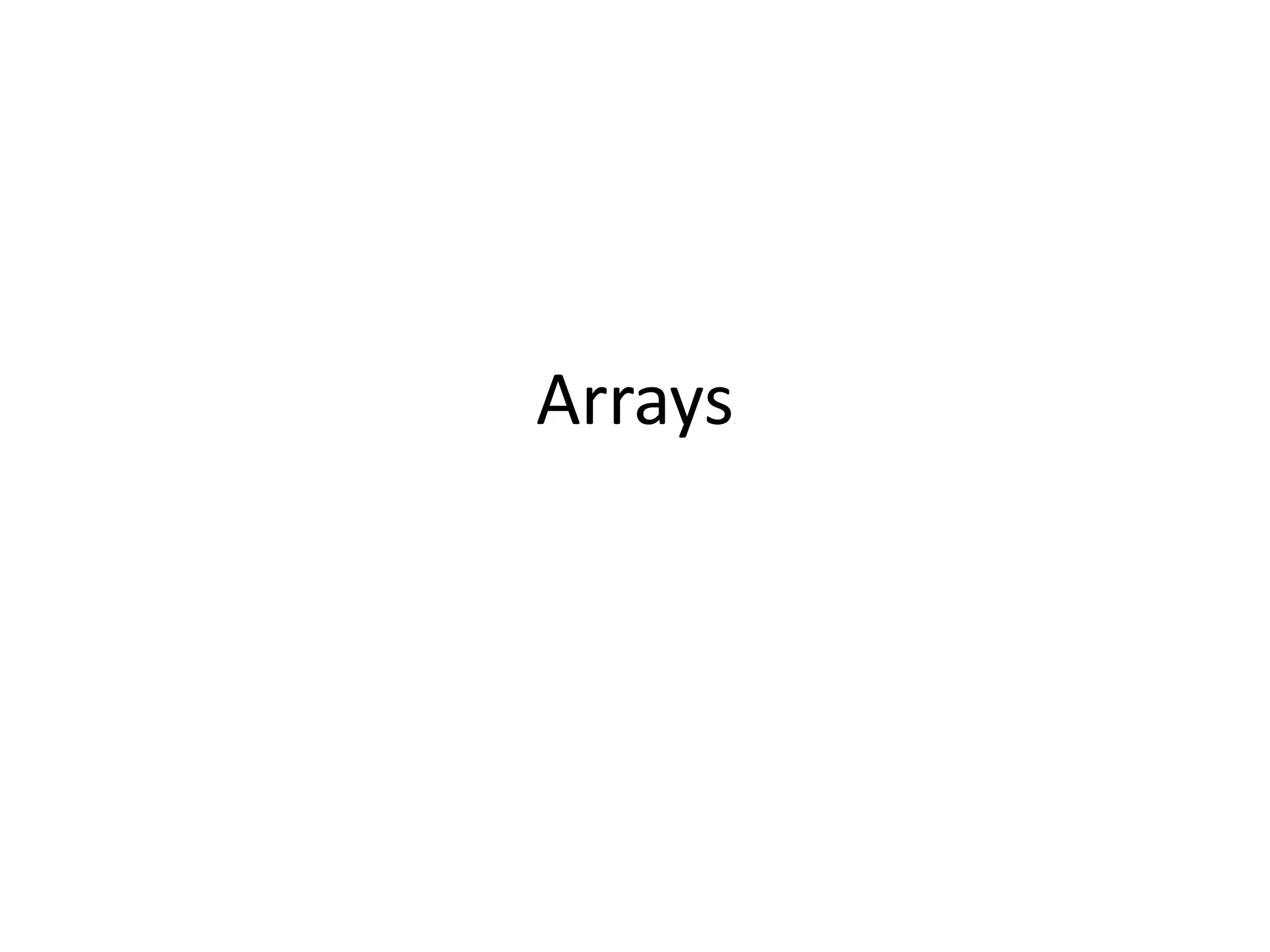
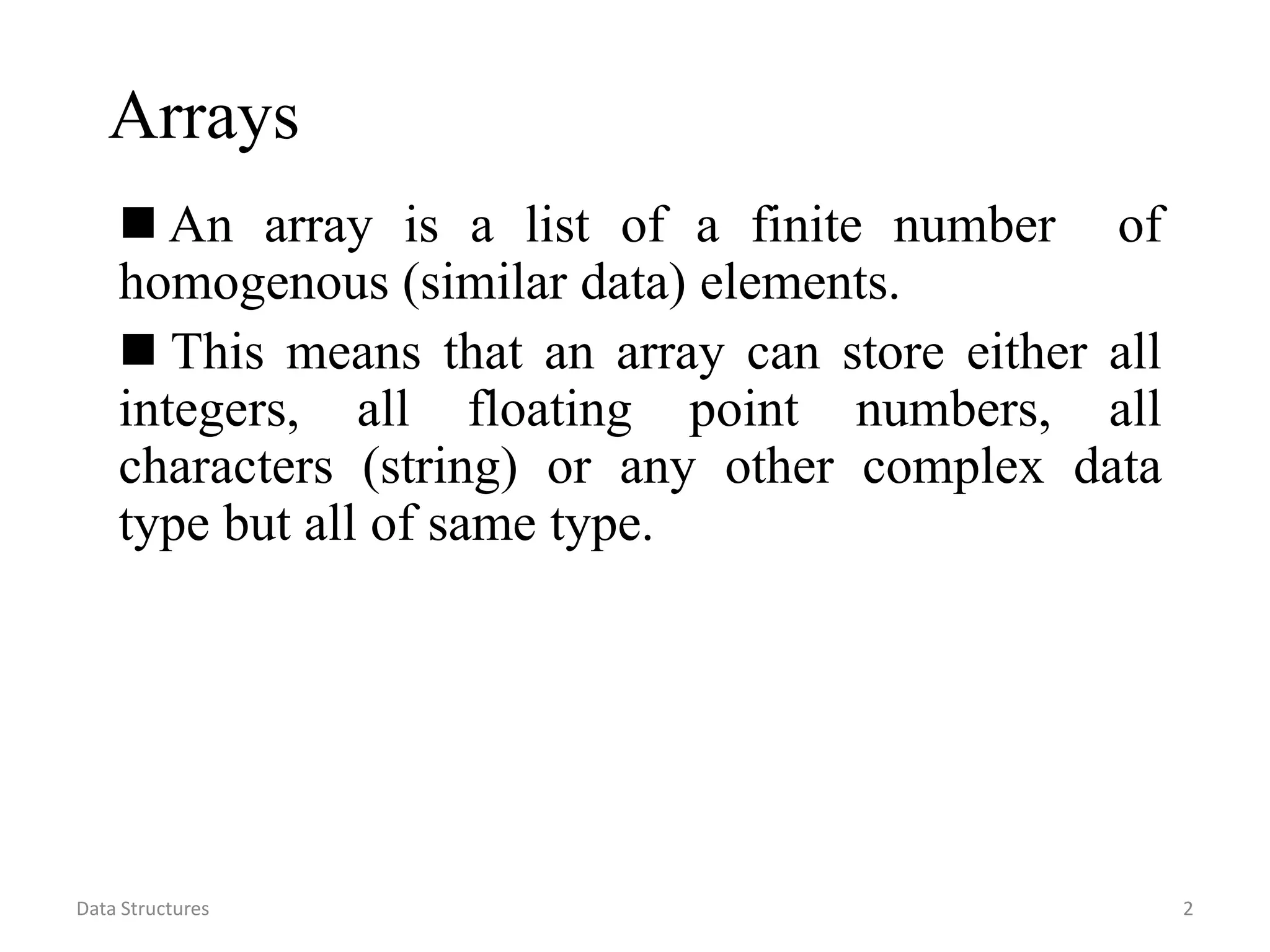
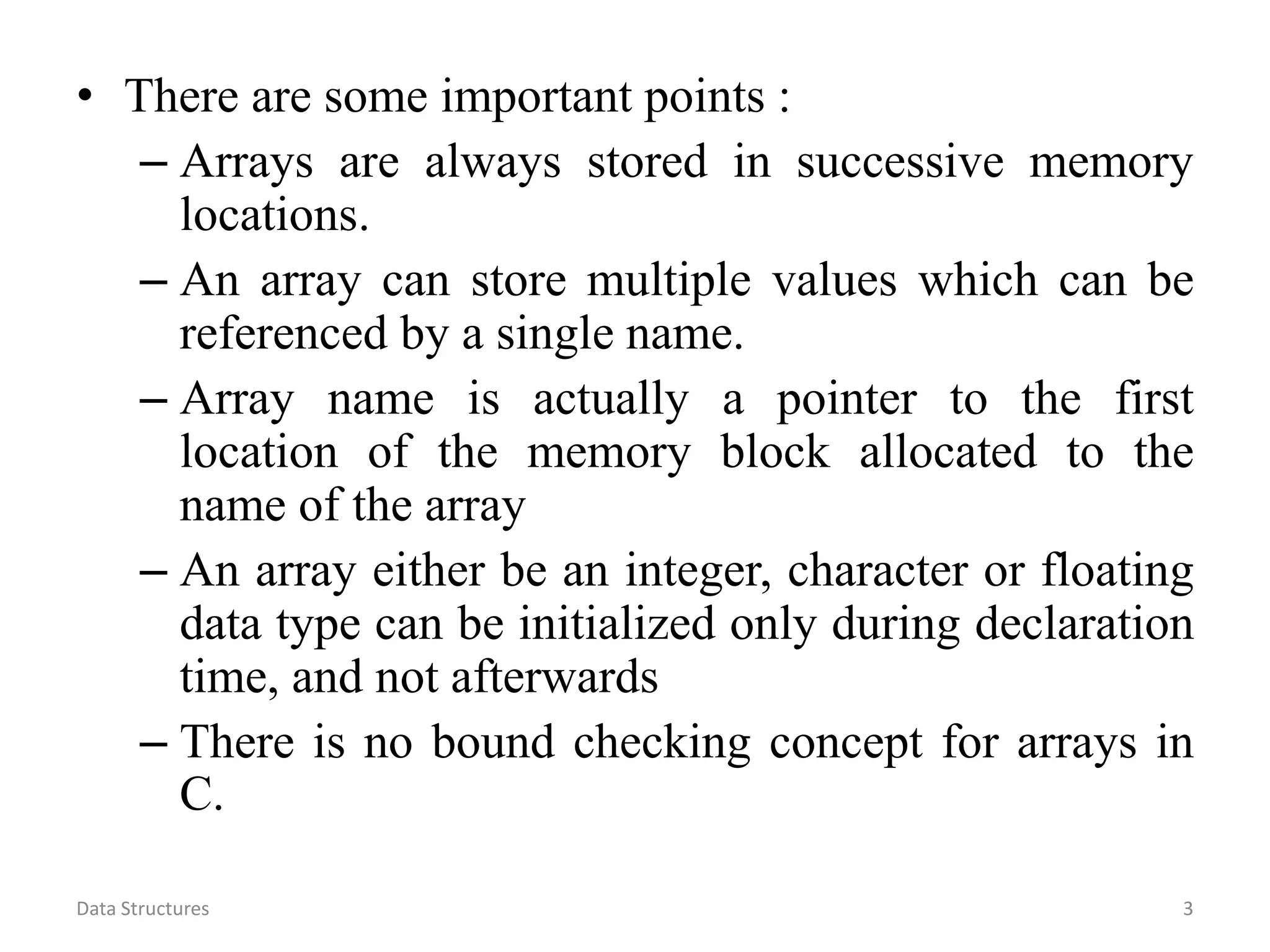
![• Elements of an array A may be denoted by the
subscript notation
A1, A2, …………… An
Or
A[1], A[2],………..A[n]
• The number n of elements is called the length
or size of the array.
• The number n in A[n] is called a subscript /
index and A[n] is called a subscript variable.
Data Structures 4](https://image.slidesharecdn.com/2-201004090527/75/2-Array-in-Data-Structure-4-2048.jpg)
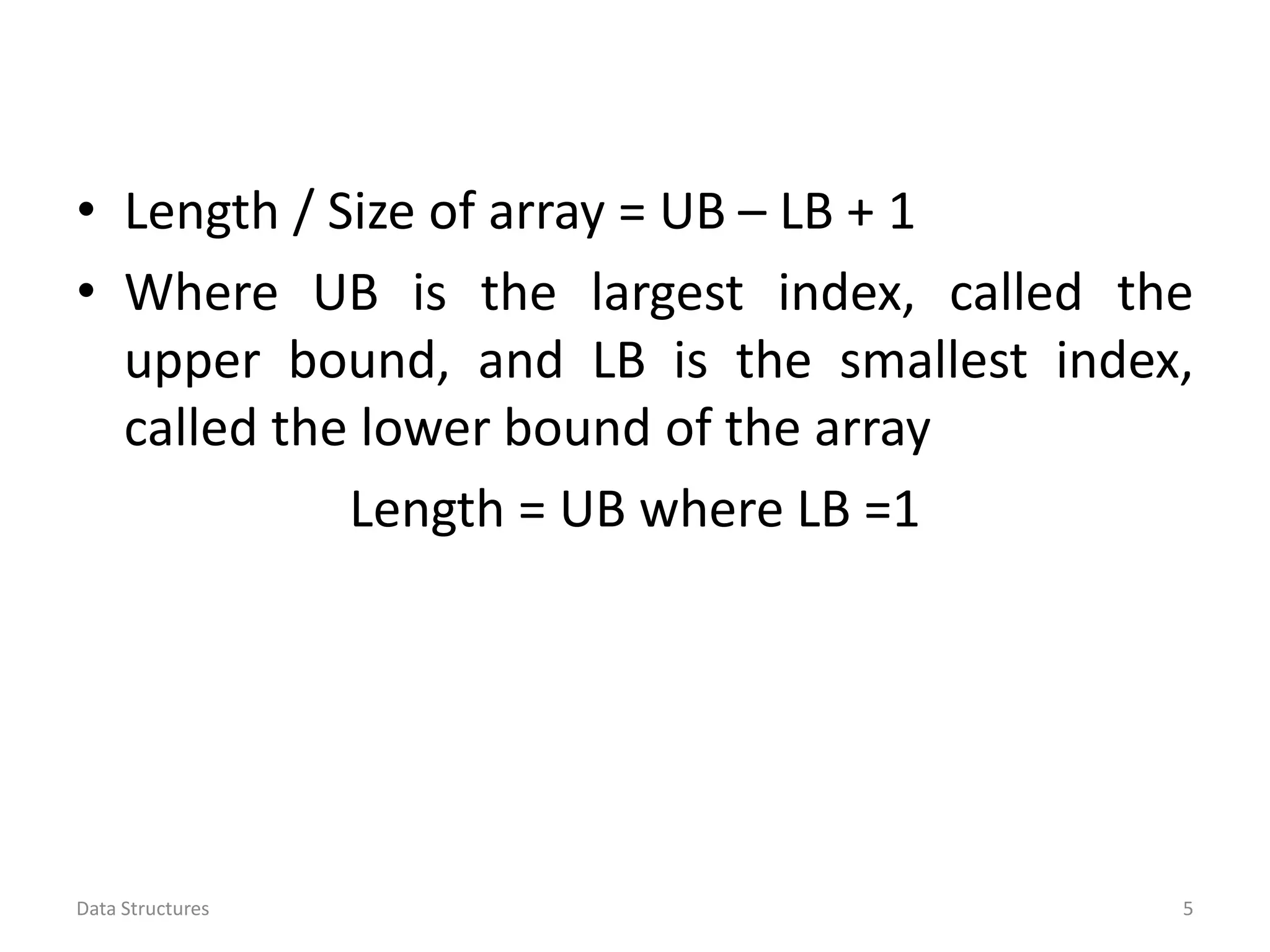
![Example
• An automobile company uses an array AUTO
to record the number of automobiles sold
each year from 1932 through 1984. Rather
than beginning the index set with 1, it is more
useful to begin the index set with 1932 so that
• AUTO[K] = number of automobiles sold in the
year K.
Data Structures 6](https://image.slidesharecdn.com/2-201004090527/75/2-Array-in-Data-Structure-6-2048.jpg)
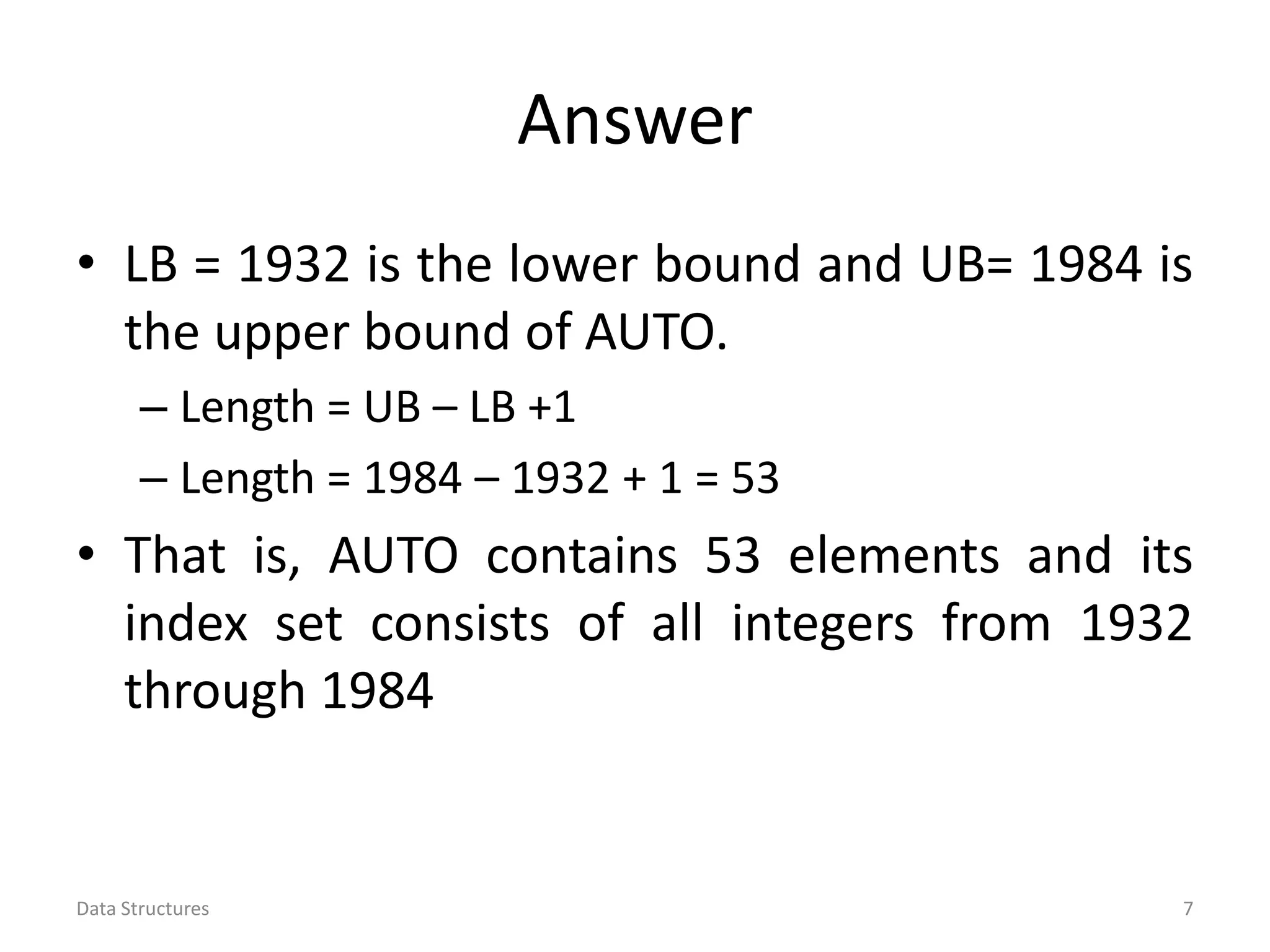
![One Dimensional Arrays
• A one dimensional array is one in which only
one subscript specification is needed to
specify a particular element of the array.
• One dimensional array can be declared as :
Data_type var_name [expression];
• Where data_type is the type of elements to be
stored in the array.
• Var_name specifies the name of array,
• Expression or subscript specifies the number
of values to be stored in the array.
Data Structures 8](https://image.slidesharecdn.com/2-201004090527/75/2-Array-in-Data-Structure-8-2048.jpg)
![• Example :
• Int num[5]
• The array will store five integer values, its
name is num
• num[0]=22, num[1] = 1, num[2]=30,
num[3]=9, num[4]=3
num
0 1 2 3 4
Data Structures 9
22 1 30 9 3](https://image.slidesharecdn.com/2-201004090527/75/2-Array-in-Data-Structure-9-2048.jpg)
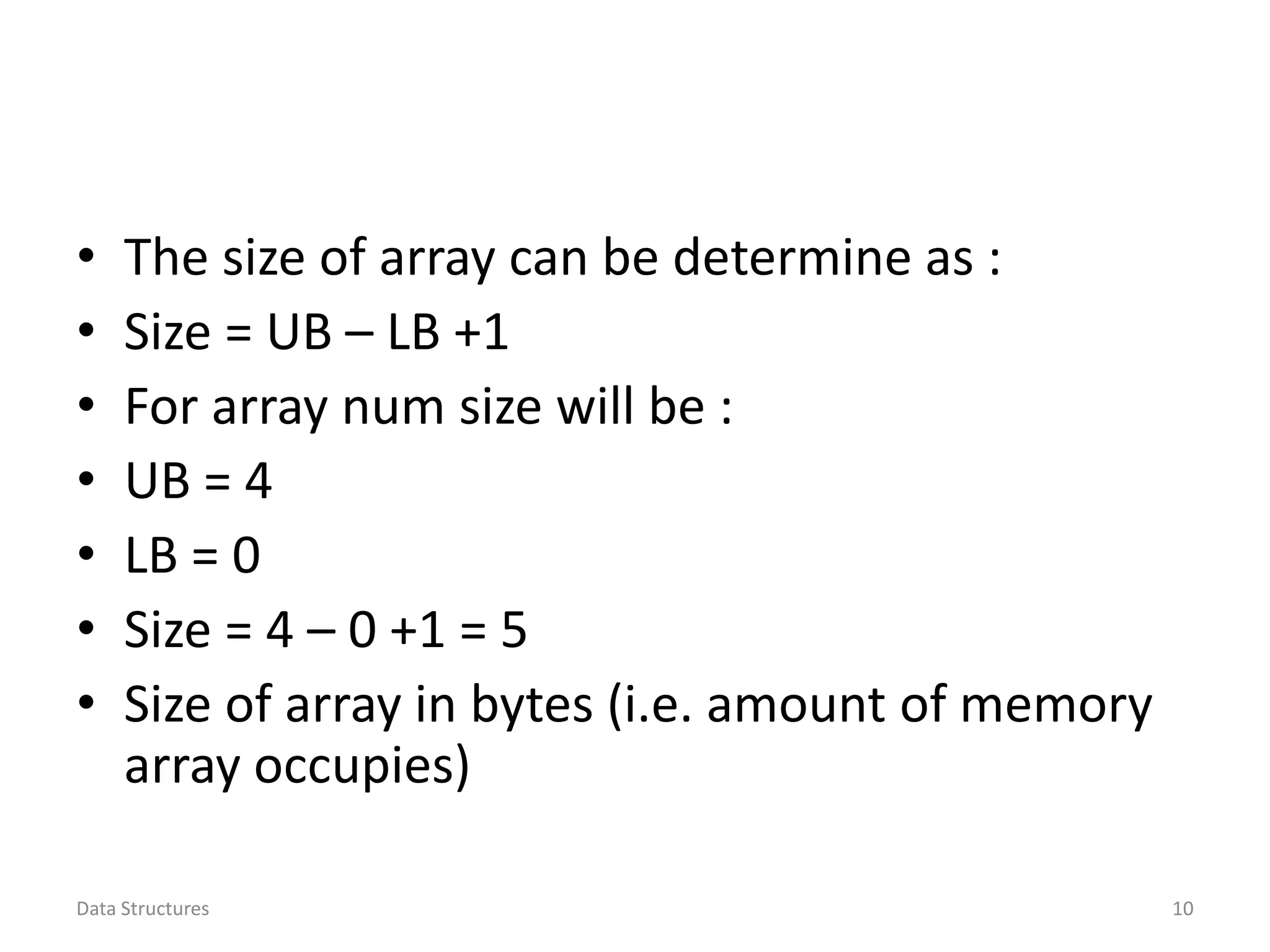
![• Size in bytes = size of array x size of base type
• E.g. if we have array
int num [5];
• Then size in bytes = 5 x 2 = 10 bytes
• Similarly, if we have array
float num[5];
• Then size in bytes = 5 x 4 = 20 bytes
Data Structures 11](https://image.slidesharecdn.com/2-201004090527/75/2-Array-in-Data-Structure-11-2048.jpg)
![Data Structures 12
Initializing Array
• int n[ 5 ] = { 1, 2, 3, 4, 5 };
– If not enough initializers, rightmost elements
become 0
–int n[ 5 ] = { 0 }
All elements 0
– If too many initializers, a syntax error occurs
– C arrays have no bounds checking!!
• If size omitted, initializers determine it
int n[ ] = { 1, 2, 3, 4, 5 };
– 5 initializers, therefore 5 element array](https://image.slidesharecdn.com/2-201004090527/75/2-Array-in-Data-Structure-12-2048.jpg)
![Data Structures 13
Addressing of element in 1-D Array
• Let A be a linear array stored in successive memory cells.
LOC(A[K]) = address of the element A[K] of the array A
1000
1001
1002
1003
• To calculate the address of any element of A formula is::
LOC(A[K])= Base (A) + w (K-lower bound)
• Base (A) =Address of the first element of A
• w =number of words per memory cell for the array
• K =any index of A](https://image.slidesharecdn.com/2-201004090527/75/2-Array-in-Data-Structure-13-2048.jpg)
![Example
• Consider the array AUTO in which records the
number of automobiles sold each year from 1932
through 1984. Suppose AUTO appears in memory as
pictured. That is Base(AUTO) = 200 and w = 4 words
per memory cell for AUTO Then
• LOC(AUTO[1932]) = 200,
• LOC(AUTO[1933])=204,
• LOC(AUTO[1934])=208,…..
• The address of the array element for the year K=1965
can be obtained by using formula.
Data Structures 14](https://image.slidesharecdn.com/2-201004090527/75/2-Array-in-Data-Structure-14-2048.jpg)
![Answer
• LOC(AUTO[1965]) = Base(AUTO) + w (1965 –
lower bound)
• LOC(AUTO[1965])= 200 + 4 (1965 – 1932)
• LOC(AUTO[1965]) = 332
Data Structures 15](https://image.slidesharecdn.com/2-201004090527/75/2-Array-in-Data-Structure-15-2048.jpg)
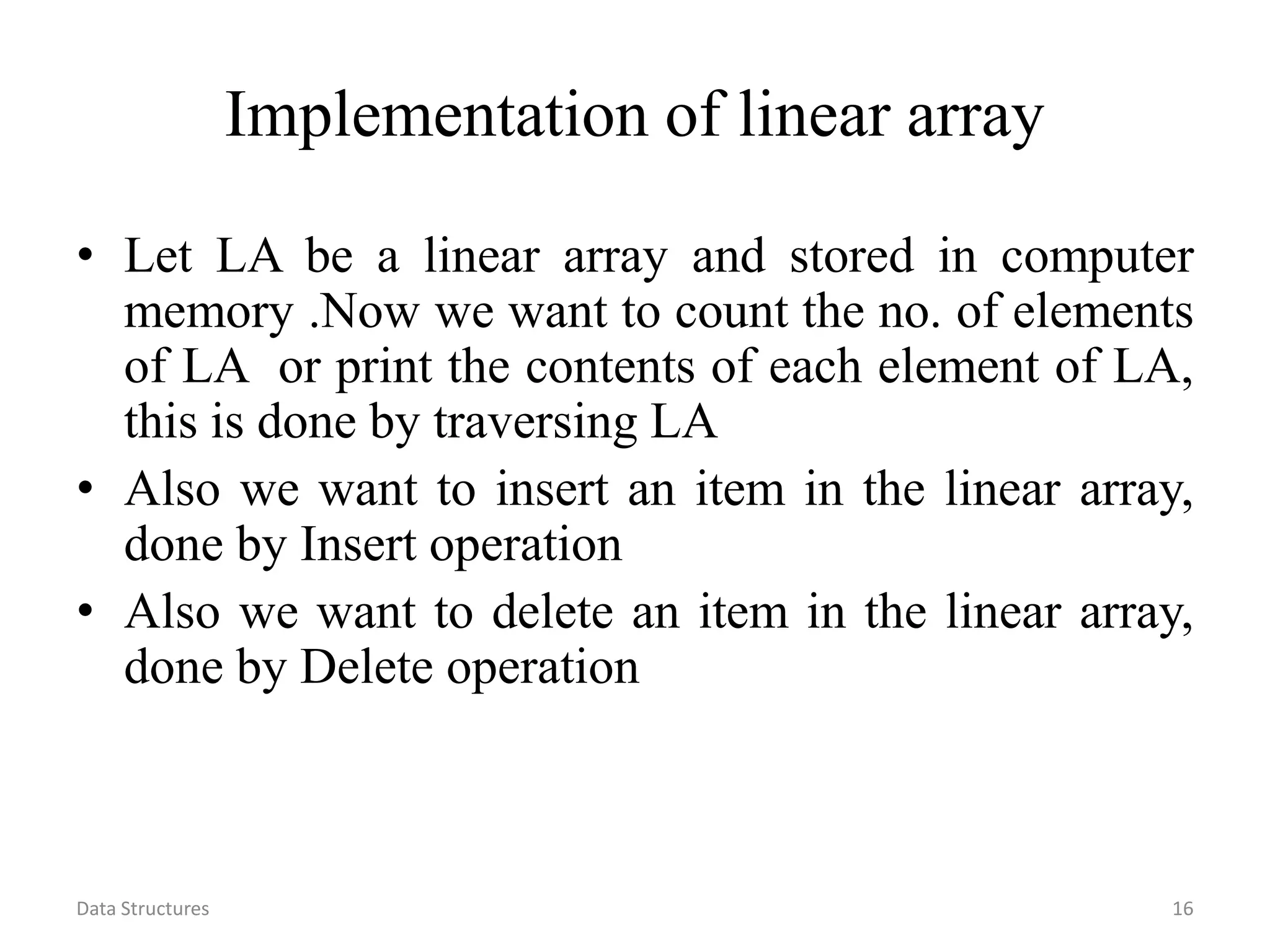
![Data Structures 17
Algo. For Traversing in linear array
• LA is a linear array with UB upper bound
and LB lower bound for traversing
we apply PROCESS to each element of LA
Steps are:
1.Set k=LB
2.Repeat step 3 and 4 while k<=UB
3.Apply PROCESS to LA [k]
4.k=k+1
5.exit](https://image.slidesharecdn.com/2-201004090527/75/2-Array-in-Data-Structure-17-2048.jpg)
![Data Structures 18
Inserting an element in array
• INSERT (LA, N, k, ITEM)
Here LA is a Linear array with N elements and K is a
positive integer. This algorithm inserts an element ITEM
into the Kth position in LA.
Steps are:
1.Set j=N
2. Repeats step 3 and 4 while j>=k
3.Set LA[j+1]=LA[j]
4.Set j=j-1
5.Set LA[k]=ITEM
6.Set N=N+1
7.Exit](https://image.slidesharecdn.com/2-201004090527/75/2-Array-in-Data-Structure-18-2048.jpg)
![Data Structures 19
Delete an element in array
• DELETE (LA, N, k, ITEM)
Here LA is a Linear array with N elements and K is a
positive integer. This algorithm deletes the Kth
element from LA.
Steps are:
1.Set ITEM = LA[k]
2. Repeat for j = k to N-1
Set LA[j] = LA[j+1]
3.Set N=N-1
4.Exit](https://image.slidesharecdn.com/2-201004090527/75/2-Array-in-Data-Structure-19-2048.jpg)
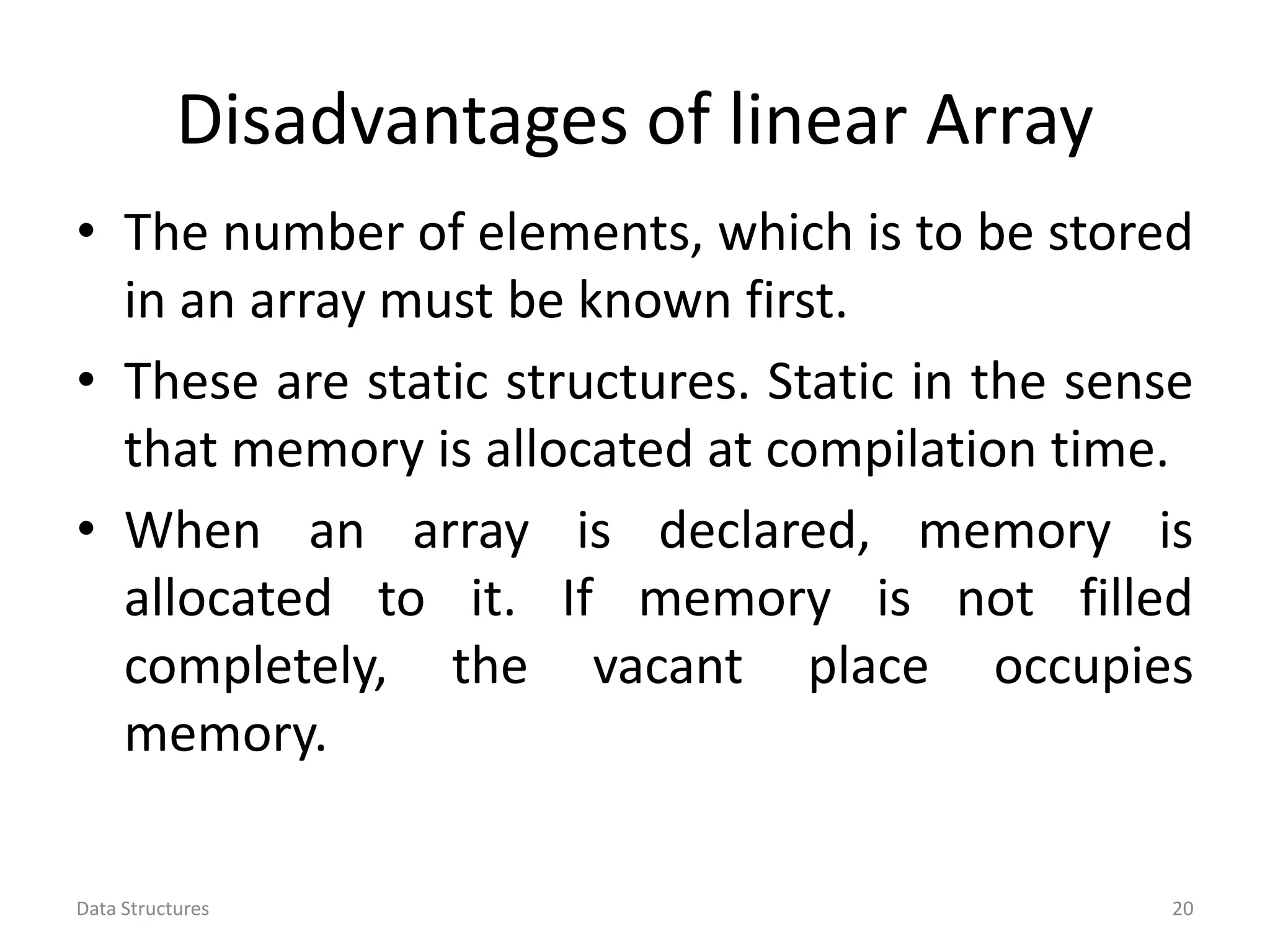
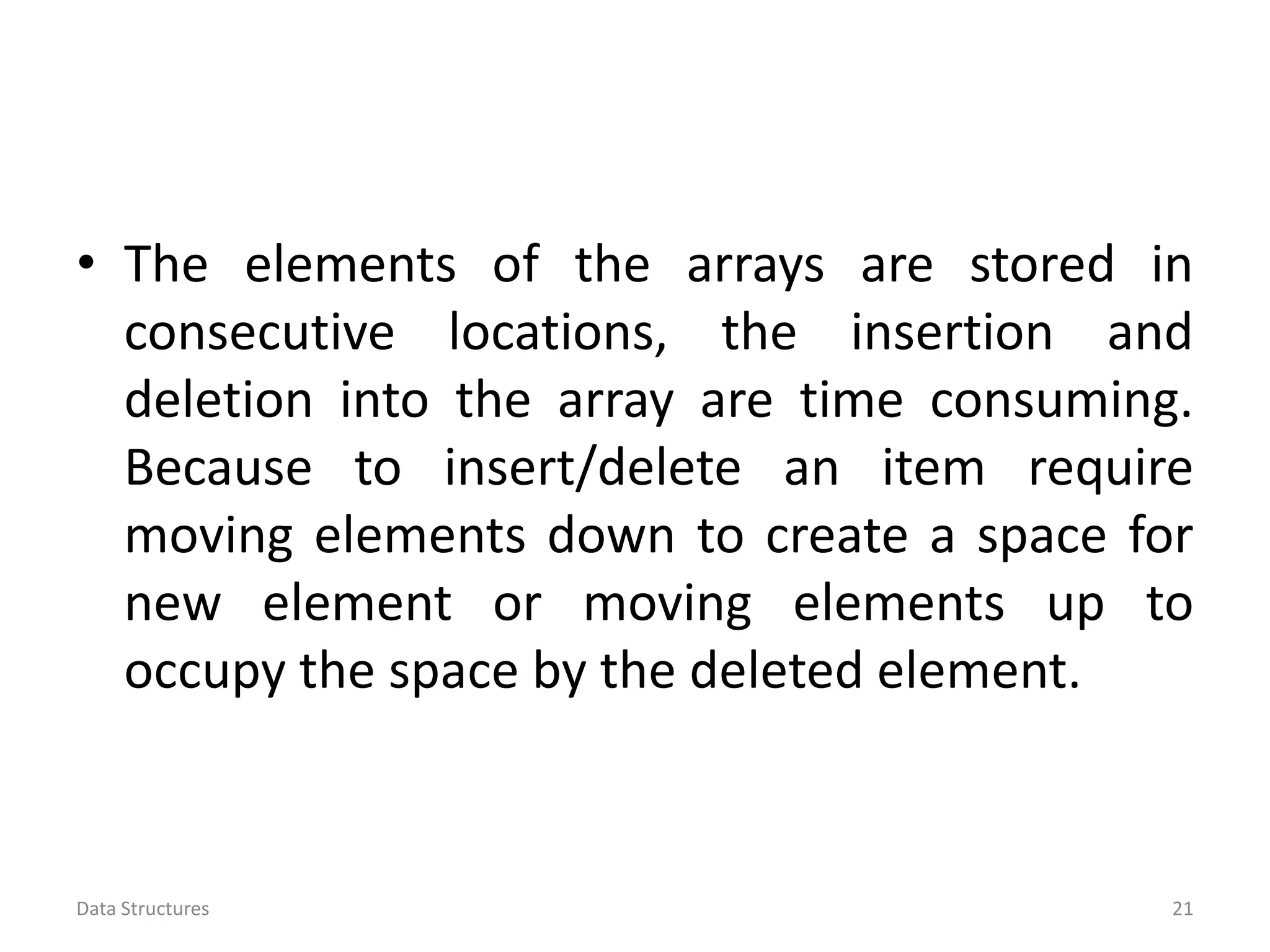
![Data Structures 22
Two-Dimensional Array (Table)
Col 0 Col 1 Col 2 Col 3 Col 4
Row 0 a[0][0] a[0][1] a[0][2] a[0][3] a[0][4]
Row 1 a[1][0] a[1][1] a[1][2] a[1][3] a[1][4]
Row 2 a[2][0] a[2][1] a[2][2] a[2][3] a[2][4]
►short a[3][5]; // a table with 3 rows,5 columns
►The first dimension denotes the row-index,
which starts with 0.
►The second dimension denotes the column-
index, which also starts with 0.](https://image.slidesharecdn.com/2-201004090527/75/2-Array-in-Data-Structure-22-2048.jpg)
![Data Structures 23
Two-Dimensional Array
• A two dimensional array A is a collection of m * n
elements and each element is specified by pair of integers
(such as J, K) called subscripts
1<=J<= m AND 1<=K<=n
• Element of A with first subscript j and second subscript k
will denoted by
AJ,K or A[J,K]
• Two-dimensional arrays are called matrices in
mathematics and tables in business applications.
• The element A[J,K] appears in row J and column K
• A row is a horizontal list of elements and a column is a
vertical list of elements.](https://image.slidesharecdn.com/2-201004090527/75/2-Array-in-Data-Structure-23-2048.jpg)
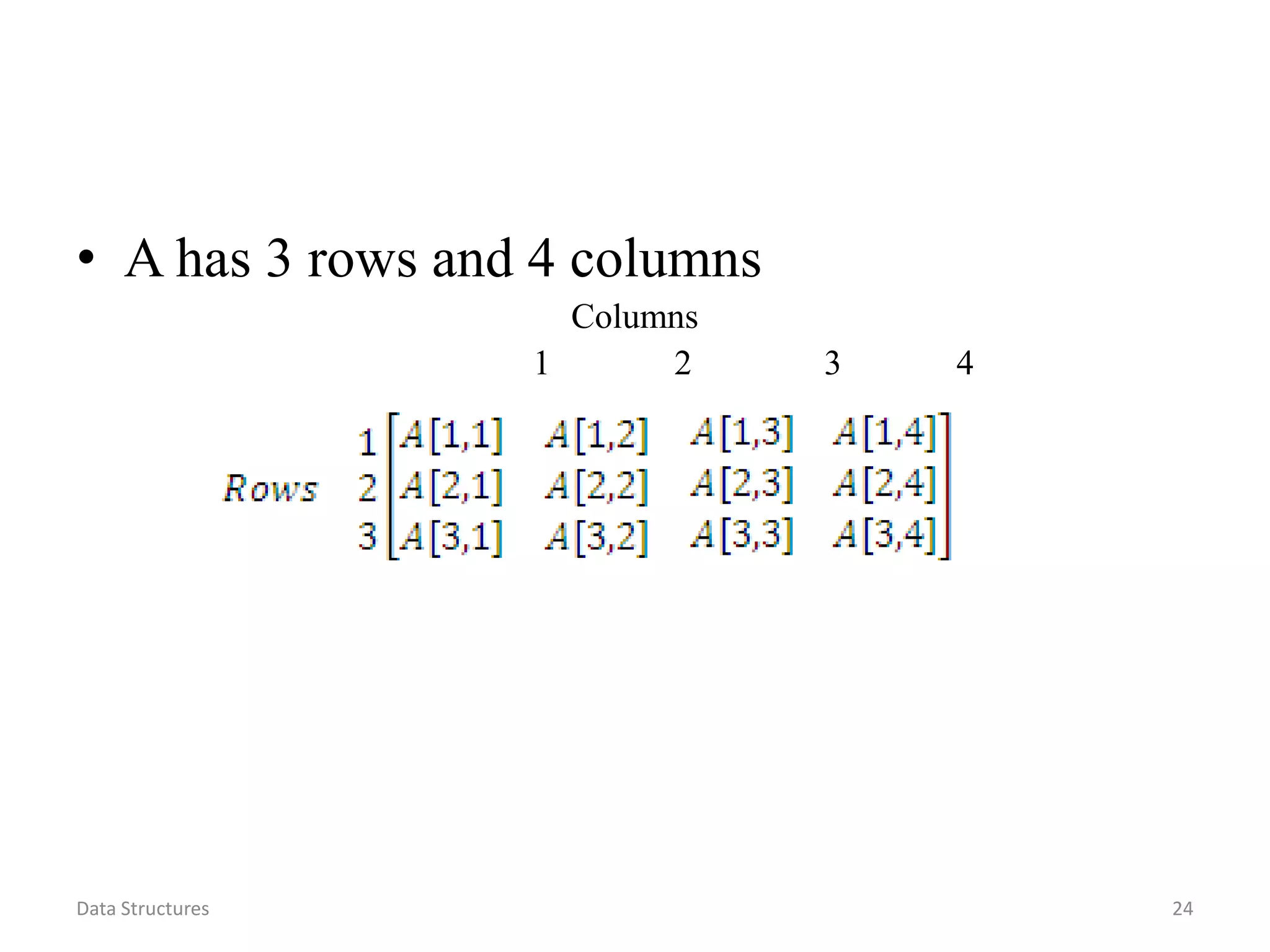
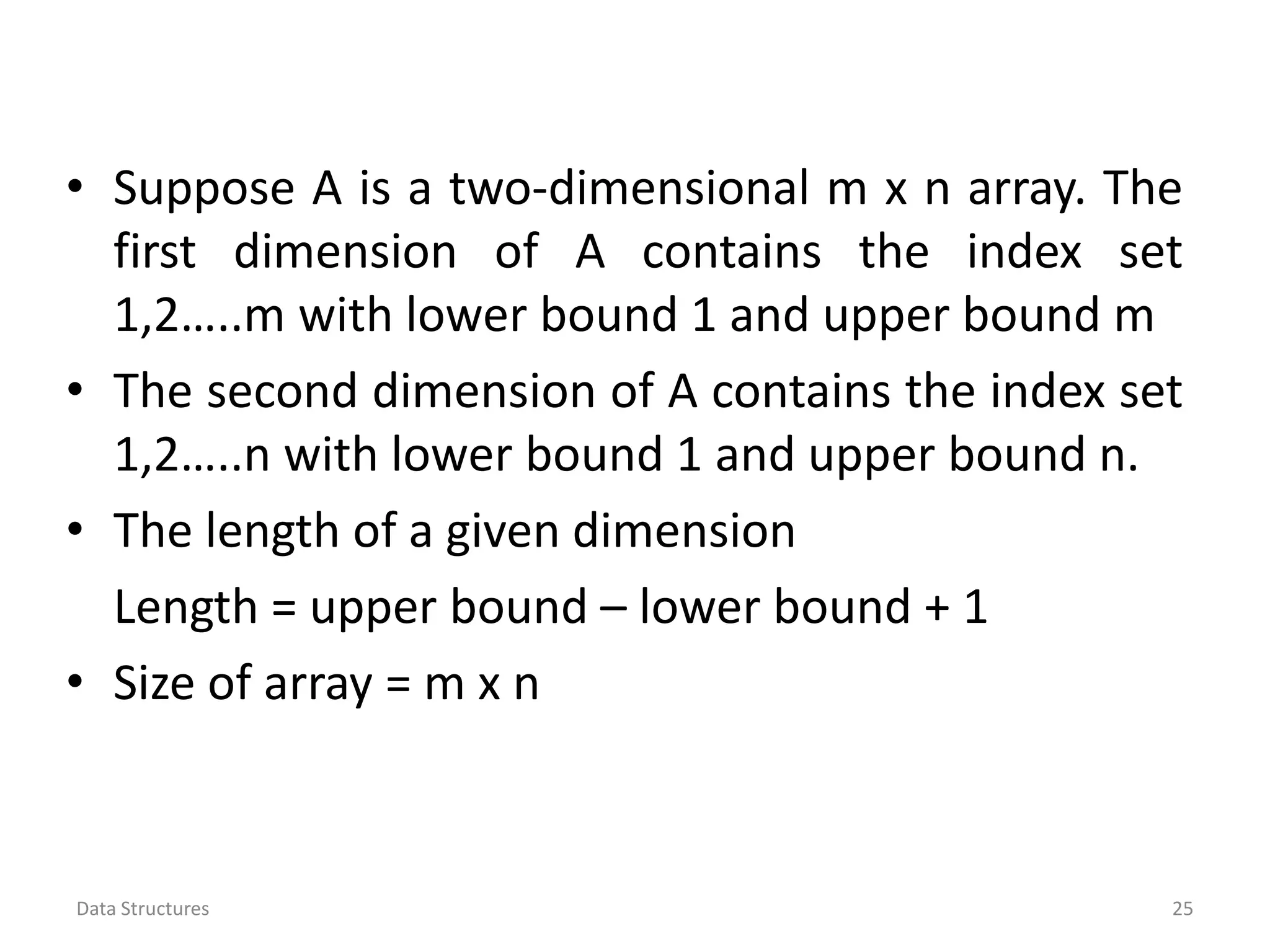
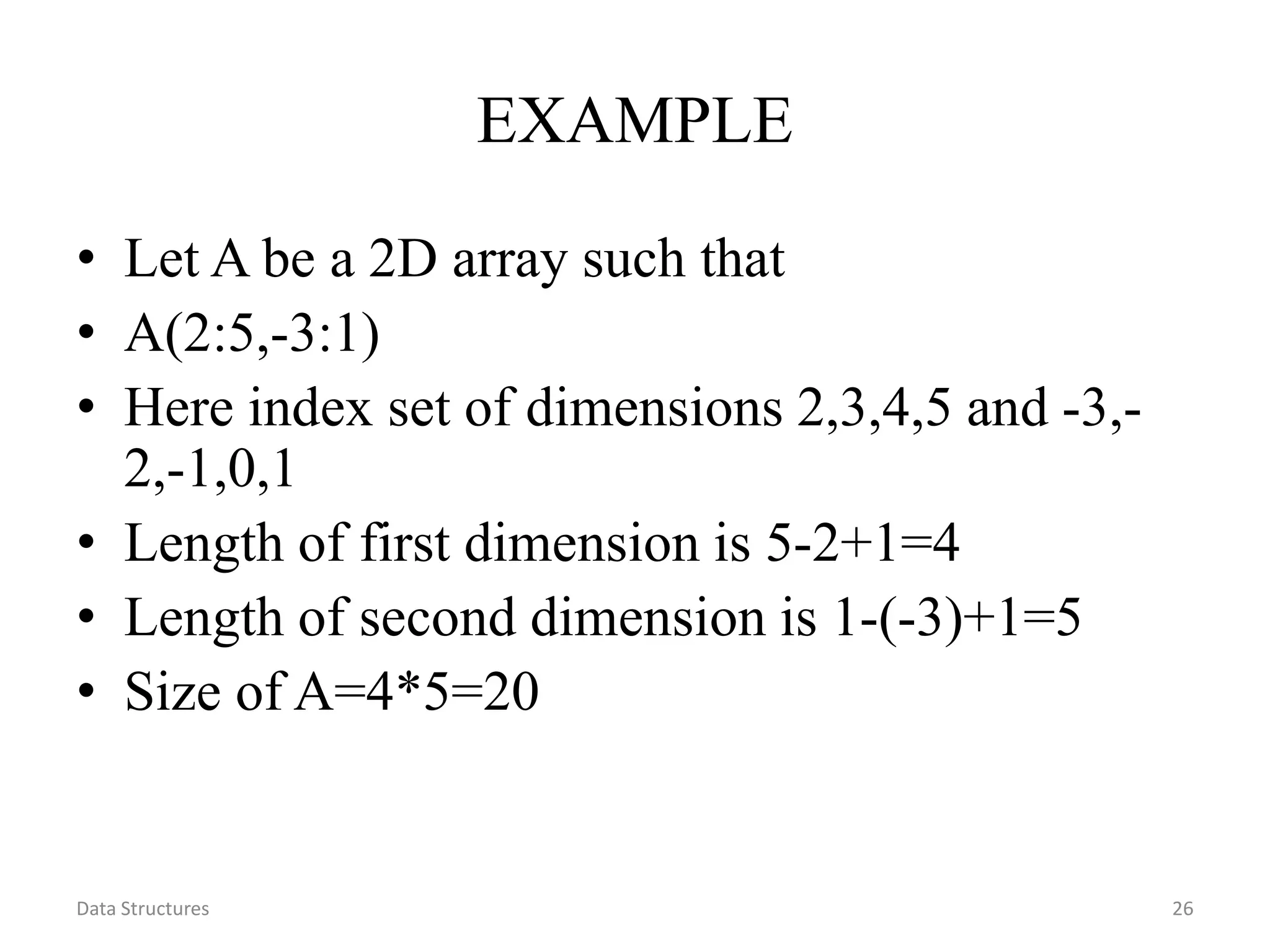
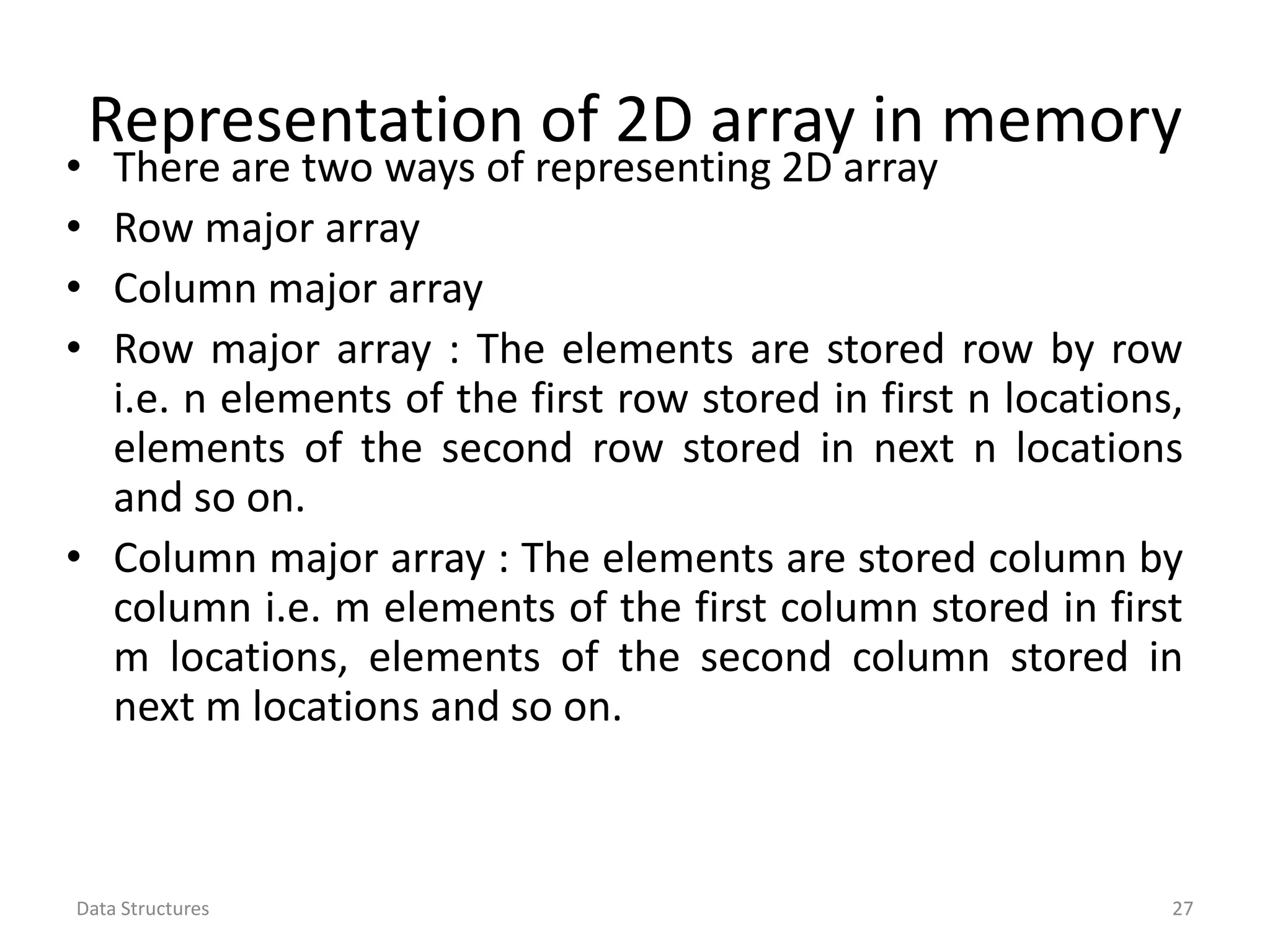
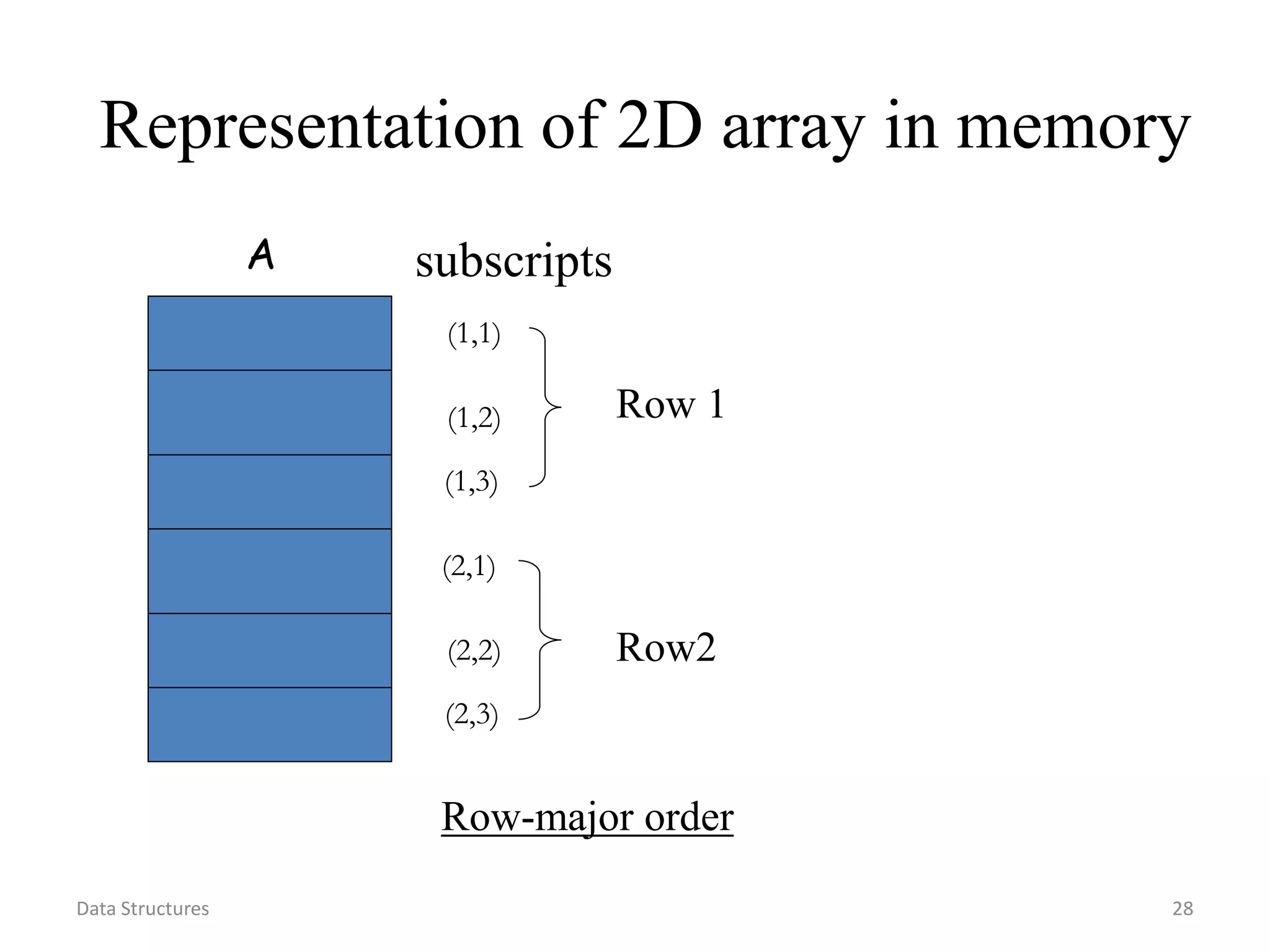
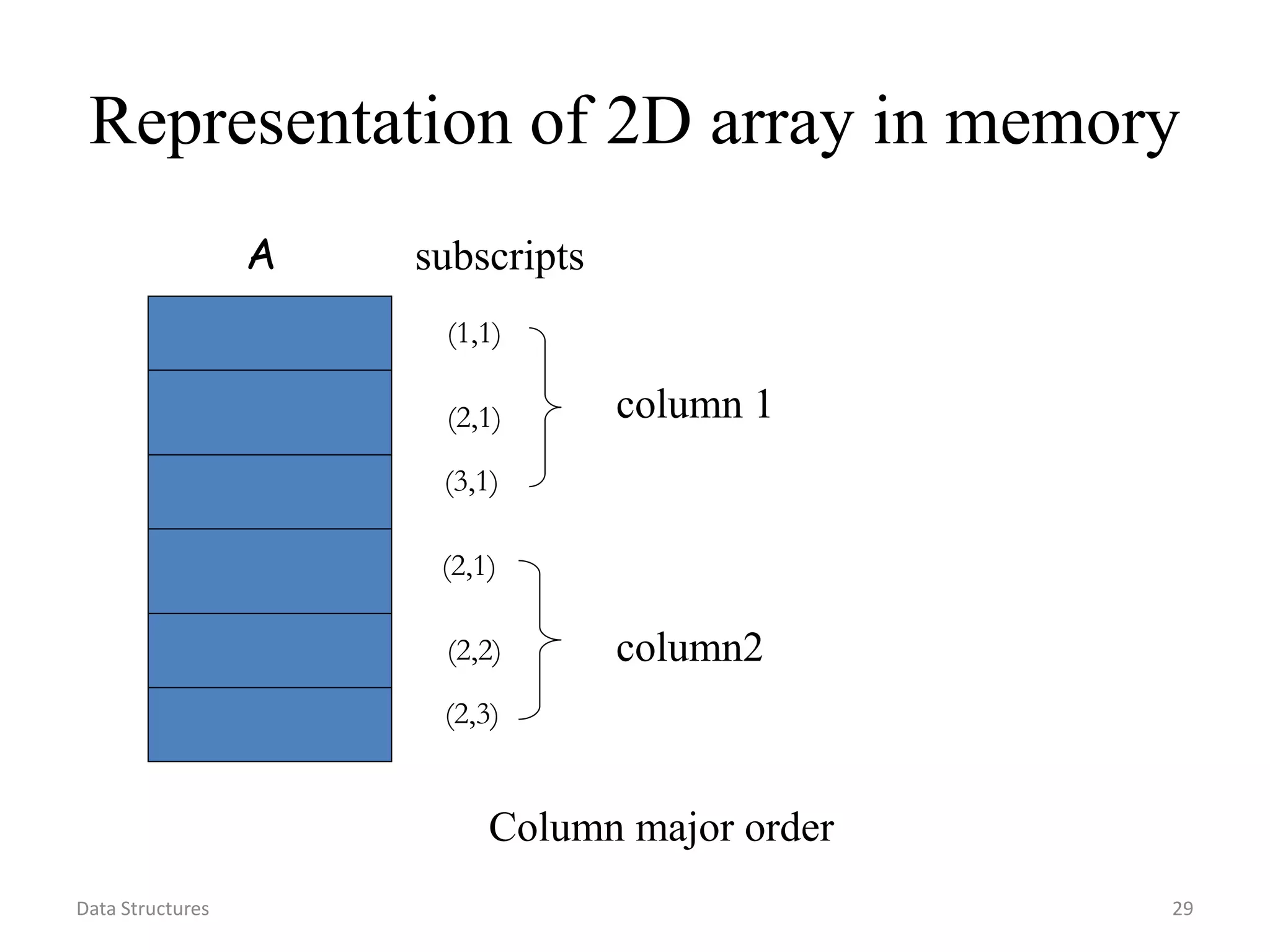
![Data Structures 30
Address calculation in 2D array
• Let a 2D array A of m*n size, to compute the LOC (A[j,k])
using the formula
LOC (A[j,k])=Base(A)+w[(N(j-1)+(k-1)]
(row major order)
Where Base(A) = address of 1st element of A, w = words per
memory cell and N = total no. of columns in array
LOC (A[j,k])=Base(A)+w[(M(k-1)+(j-1)]
(column major order)
Where Base(A) = address of 1st element of A, w = words per
memory cell and M = total no. of rows in array](https://image.slidesharecdn.com/2-201004090527/75/2-Array-in-Data-Structure-30-2048.jpg)
![Example
• Consider the 25 x 4 matrix array SCORE.
Suppose Base(SCORE) = 200 & w= 4. Calculate
the address of SCORE = [12,3] i.e. the 12th row
and 3 column using row major order and
column major order.
Data Structures 31](https://image.slidesharecdn.com/2-201004090527/75/2-Array-in-Data-Structure-31-2048.jpg)
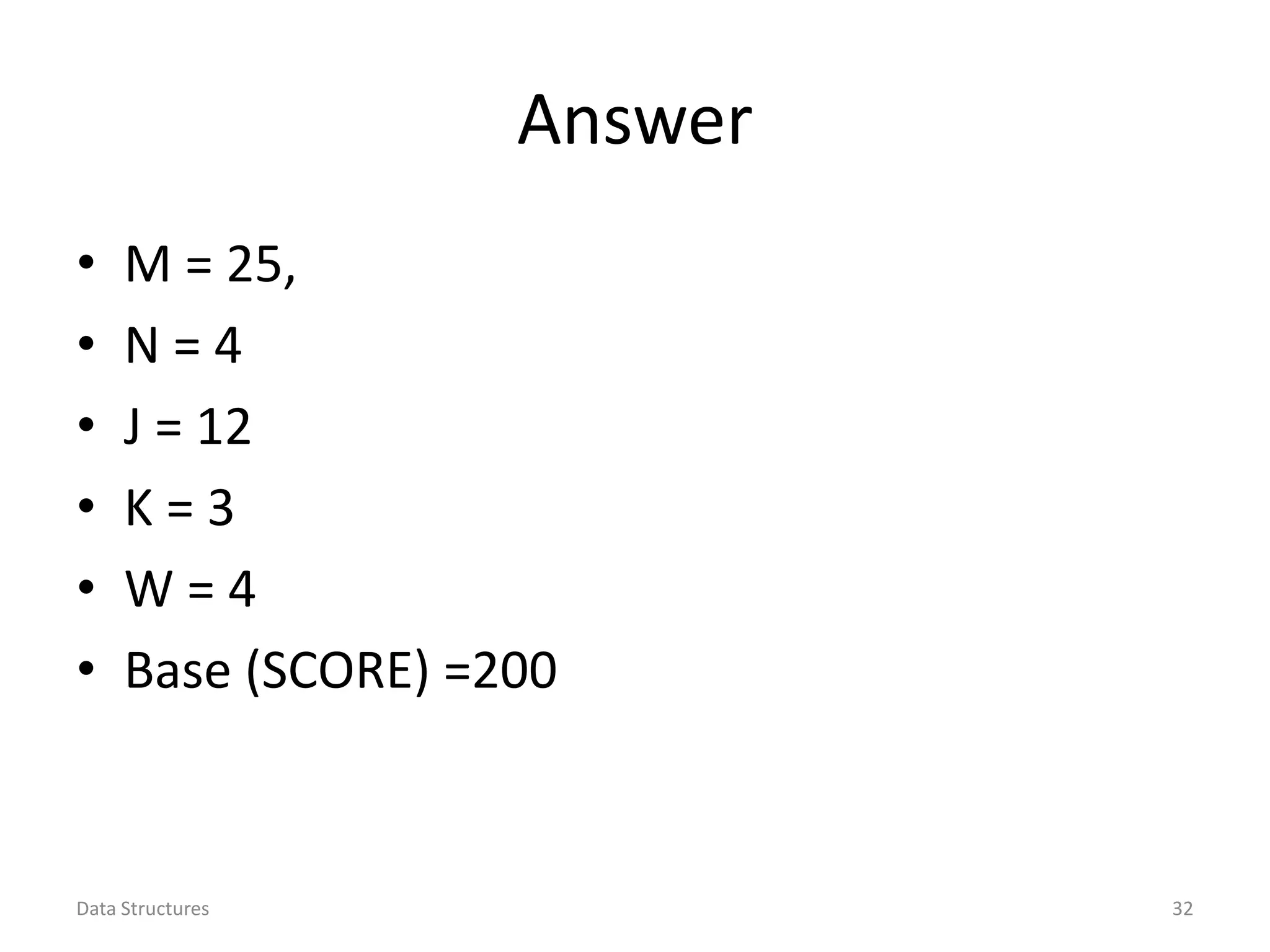
![Using Row-major order
• LOC (SCORE[12,3]) = Base (SCORE) + w [N(J-1) + (K-1)]
= 200 + 4 [4(12-1) + (3-1)]
= 200 + 4 [4(11) + 2)]
= 200 + 4 [44 +2]
= 200 + 4 [46]
= 200 + 184
= 384
Data Structures 33](https://image.slidesharecdn.com/2-201004090527/75/2-Array-in-Data-Structure-33-2048.jpg)
![Using Column Major Order
• LOC (SCORE[12,3]) = Base (SCORE) + w [M(K-1) + (J-1)]
= 200 + 4 [25(3-1) + (12-1)]
= 200 + 4 [25(2) + 11)]
= 200 + 4 [50 +11]
= 200 + 4 [61]
= 200 + 244
= 444
Data Structures 34](https://image.slidesharecdn.com/2-201004090527/75/2-Array-in-Data-Structure-34-2048.jpg)
![Multidimensional Array
• When array can be extended to any number of
dimensions. E.g. 3D array may be defined as :
• int a[2][4][3]
• Multidimensional array also called arrays of
arrays
• Suppose C is a 3D 2 x 4 x 3 array. Then B
contains 2 x 4 x 3 = 24 elements. These
elements appear in 3 layer called pages,
column and row.
Data Structures 35](https://image.slidesharecdn.com/2-201004090527/75/2-Array-in-Data-Structure-35-2048.jpg)